The Training Need Analysis Checklist Every L&D Practitioner Needs Right Now
Before conducting a training need analysis, make sure to compare it against the following checklist:
| S. No. |
Priorities |
| 1 |
Figure out what the company wants to accomplish. |
| 2 |
Understand the history of training within the organization. |
| 3 |
Zero down on the specific needs that will be addressed by the training. |
| 4 |
Identify if there have been any latest process/procedure changes. |
| 5 |
Think about the kind of resources that are available for training. |
| 6 |
Understand who needs to be trained. |
| 7 |
Identify who will serve as the subject matter experts. |
| 8 |
Analyze which companies can provide the training materials. |
| 9 |
Review the Job Descriptions and Organization Charts. |
For a more in-depth checklist, refer to the following:
Step 1: Identify the main goals of the new training program.
The L&D team should comprise Subject Matter Experts and learning strategists. This step includes:
- Identifying the skills and knowledge required by the employee to reach the KPI targets and how the KPIs can be measured
- Categorizing the challenges that affect the KPI scores and prioritizing tasks to address the same
- Validating the project scope and understanding the key learning objectives, competency levels, and possible delivery methods
Step 2: Conduct an organizational analysis.
If the project requires a complete overhaul of the training program, its organizational impact needs to be understood. To validate the business needs, ask the following questions:
- What is the business problem the company is trying to solve?
- What are the organization's unique goals for the training program?
- Why is a training program instrumental in solving the business problem?
- How well is the organization experience with respect to training and development?
Step 3: Conduct a people/trainee analysis.
This step requires creating a profile of the trainees in relation to key areas such as industry experience, communication skills, etc. The inputs can come in from the recruitment team. Real samples of calls, emails, chats, etc. can be examined to analyze the trainees' strengths and weaknesses. This can be done by answering the following important questions:
- Who is the ideal target audience for the training program?
- What is the trainee' existing knowledge level on the subject at-hand?
- What kind of learning styles do the trainees prefer?
- What is the kind of experience that the trainees have with training programs?
- What do the end-goals for the trainees look like?
Step 4: Conduct a task analysis.
This step involves understanding the job/task at hand. Additionally, the main duties
and skill levels required for the training program need to be identified. To do this,
Subject Matter Experts, high-performing employees, supervisors, and managers in charge
can be interviewed.
Start by asking the following questions:

- What key task is this training targeting?
- What kind of sequential steps need to be performed?
- How often should the training be performed?
- What training is already available?
- Will you need to observe the employees performing these tasks to get more data?
- Can the tasks identified be embedded into the learning program?
- Will there be any changes to the policies, procedures, or equipment due to the training program?
Step 5: Conduct a performance analysis.
This analysis is important to setting the right expectations and using accurate metrics to assess program
success. Ask the following questions to create an in-depth analysis:

- How will the training program improve performance?
- How will it improve the trainee' performance, behavior, etc.?
- Can the training by itself achieve the performance expectations?
- How will you measure performance change?
- What are the performance pain-points?
Step 6: Conduct a content analysis.
One of the most integral aspects of Training Need Analysis is content analysis. Often done
in collaboration with Subject Matter Experts, content analysis can be aced by asking the
following questions:
- What are the training's learning objectives and outcomes?
- What kind of activities, resources, external references, assessment, and evaluation processes will be required to complete the training?
- Where will the information come from? Do you have access to existing manuals, documents, guides, etc.?
- What level of competency do the learners exhibit?
- Do the learners need to complete certain tasks in a specific manner once the training is complete?
- Do the learners need to master the task or have a basic knowledge of the same?
- Do you have enough content to ensure that each training objective is met?
- Who will the main Subject Matter Expert be?
- Who will be the main reviewer and approver?
- Does the course material involve tasks for different learning styles, group work, problem-solving, peer evaluation, and real-time feedback?
- Is the course structure in a proper flow? Does it elicit a good level of understanding and engagement from the learners?
- Is the material clearly and realistically connected to the course objectives?
- Is the course content relevant and appropriate for the background, abilities, and experience of the learners?
Based on the data collected and by studying the existing course material, a design document including the relevant training objectives can be created. This can be used as the foundation for creating the new training course material.
Step 7: Conduct a cost-benefit analysis.
This step involves being able to demonstrate the return on investment of the learning and
development initiative. To do this, factor in all the key metrics and KPIs that can drive the
ROI. Also account for the costs of development, delivery, assessment, metric reporting, and so
on.
Bringing it All Together
Evidently, there is a significant shift in the way companies are driving L&D programs. They are increasingly treating "learning" as a strategic asset. Moreover, to recruit high-quality talent, organizations are driving engaging, memorable, and "employee-obsessed" programs.
Contrary to popular opinion, learning and development programs are not just beneficial for the employee; they also hold great value for the organization. This includes higher customer satisfaction, increased revenues, and a significantly happier employee base. That said, for organizations to leverage L&D as a competitive advantage, there needs to be a shift in the organization's HR and learning culture. It is only with continuous learning can enterprises hope to innovate with a future-ready workforce at the helm.
Finally, at the core of value-driven organizations is an ever-evolving, strategic, and skilled workforce—one that's powered by learning-centric culture and training-led design thinking.







